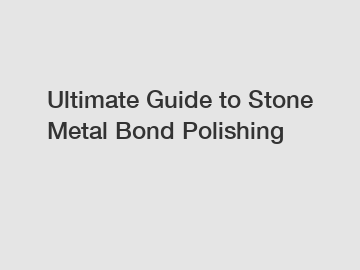Ultimate Guide to Stone Metal Bond Polishing
Are you looking to achieve a stunning, high-gloss finish on your stone surfaces? Look no further than stone metal bond polishing. This method is the ultimate solution for achieving a flawless, mirror-like finish on a wide range of stone materials.
With years of experience and expertise in the industry, we have compiled the ultimate guide to stone metal bond polishing to help you achieve professional results every time.
What is Stone Metal Bond Polishing?

Stone metal bond polishing is a process that involves using specialized tools and techniques to grind and polish stone surfaces to achieve a smooth, high-gloss finish. This method is ideal for a variety of stone materials, including marble, granite, limestone, and more.
The process involves using metal-bonded diamond tools to grind and polish the surface of the stone. These tools are designed to be highly durable and effective at removing scratches, stains, and other imperfections from the surface of the stone.
The Ultimate Guide to Stone Metal Bond Polishing.
1. Preparation is Key.
Before beginning the stone metal bond polishing process, it is essential to properly prepare the surface of the stone. This includes cleaning the surface to remove any dirt, dust, or debris that may be present. Additionally, any existing stains or scratches should be treated before moving on to the polishing process.
2. Choose the Right Tools.
When it comes to stone metal bond polishing, choosing the right tools is crucial for achieving professional results. Metal-bonded diamond tools come in a variety of grit sizes, each designed for a specific purpose. Coarser grits are used for grinding down the surface of the stone, while finer grits are used for polishing and achieving a high-gloss finish.
3. Start with Coarse Grits.
To begin the polishing process, start with a coarse grit diamond tool to grind down the surface of the stone and remove any imperfections. It is important to use a consistent pressure and motion while grinding to ensure an even finish. Once the surface has been ground down to the desired level, move on to finer grits to achieve a smooth, polished finish.
4. Use Water.
Using water during the polishing process helps to cool the diamond tools and prevent overheating. It also helps to reduce the amount of dust created during grinding, making for a cleaner work environment. Additionally, water helps to lubricate the surface of the stone, allowing the diamond tools to glide smoothly over the surface.
5. Work in Sections.
When polishing larger stone surfaces, it is important to work in small sections to ensure that each area is properly polished. This allows for better control over the polishing process and helps to achieve a uniform finish across the entire surface of the stone.
6. Check Your Progress.
As you work through the polishing process, be sure to regularly check your progress to ensure that the surface is being polished evenly. Look for any areas that may need additional polishing or touch-ups and adjust your technique as needed.
7. Finish with Fine Grits.
Once you have achieved the desired level of polish with the finer grit diamond tools, finish the process with an ultra-fine grit to achieve a mirror-like finish. This final step helps to remove any remaining scratches or imperfections and leaves the surface of the stone looking flawless.
Achieving Professional Results.
Stone metal bond polishing is a highly effective method for achieving a stunning, high-gloss finish on a variety of stone surfaces. With the right tools, techniques, and attention to detail, you can achieve professional results that will impress even the most discerning clients.
Our years of experience and expertise in the industry have given us the knowledge and skills needed to achieve flawless results with stone metal bond polishing. Trust in our expertise and experience to help you achieve the perfect finish on your stone surfaces every time.
For more information, please visit drill bits for granite, bush hammer roller, diamond cutting tools suppliers.


